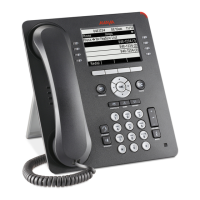Network requirements
34 Administering Avaya 9601/9608/9608G/9611G/9621G/9641G IP Deskphones SIP
Comments? infodev@avaya.com
Therefore, an SSH user cannot execute the phone-report script as the script execution requires
write-access to some folders as well as read-access to some private data.
To enhance security, 9600 Series IP Deskphones support Secure Real-time Transport Protocol
(SRTP). SRTP provides confidentiality and message authentication to media traffic going over
the LAN infrastructure. This allows the deskphones to encrypt the calls between two or more
endpoints, to restrict anyone from eavesdropping.
In order to correctly use SRTP, there are various components within the network that you must
correctly configure. For 9600 Series IP Deskphones to function properly with SRTP, you must
configure the equivalent parameters in Communication Manager or System Manager. You must
configure the following three parameters on 9600 Series IP Deskphones and the equivalent
Communication Manager parameters must match:
SET ENFORCE_SIPS_URI 1
SET SDPCAPNEG 1
SET MEDIAENCRYPTION X,9 or
SET MEDIAENCRYPTION X (where X is a value from 1 to 8)
The deskphones notify you whenever you are in a secure call, using TLS and SRTP. The
deskphones display a secure call icon, a small padlock icon, on the call line, to indicate that you
are in a secure call and that the call is encrypted.
The support for Transport Layer Security (TLS) and SRTP allows 9600 Series IP Deskphones
to establish a secure connection to a HTTPS server, in which the upgrade and settings file can
reside.
Communications between the SIP deskphone and the Personal Profile Manager (PPM) can
also be secured by setting the CONFIG_SERVER_SECURE_MODE parameter.

